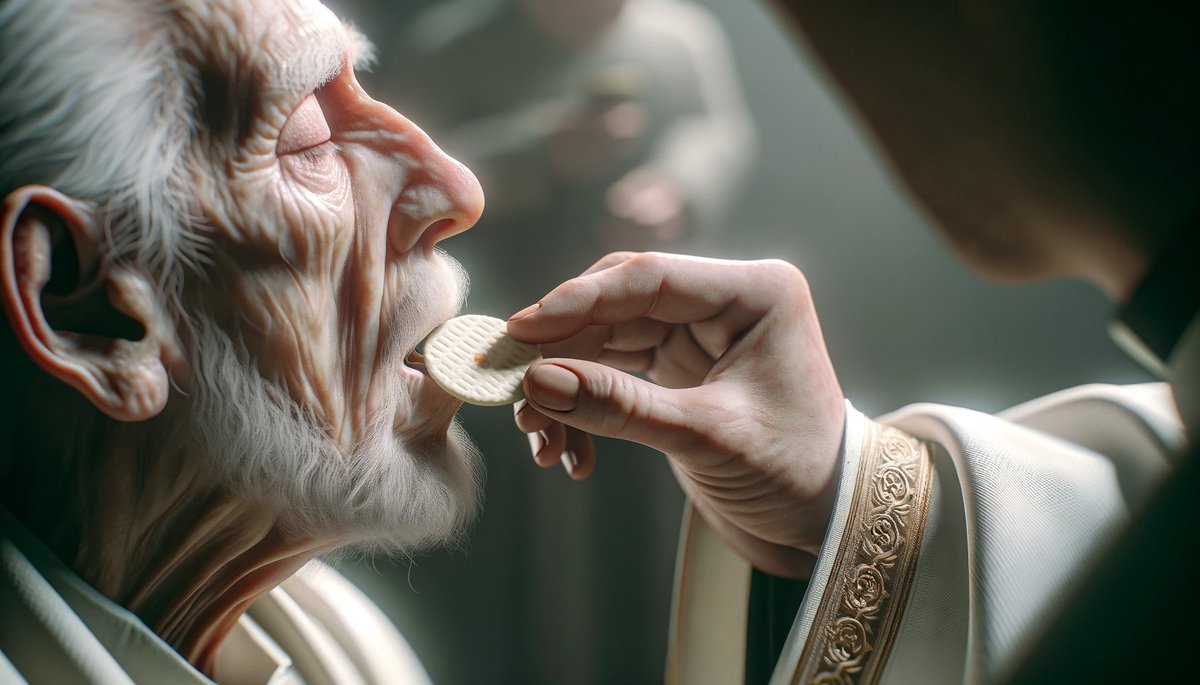Home>Theology and Spirituality>How To Do Communion Service


Theology and Spirituality
How To Do Communion Service
Published: February 19, 2024
Ericka Andersen, an editor at Christian.net, expertly merges digital strategy with content creation, focusing on faith and societal issues. Her communication skills enhance the platform's engaging narratives, fostering meaningful dialogue on belief's impact on society.
Learn how to conduct a meaningful communion service with our comprehensive guide. Explore the theology and spirituality behind this sacred practice.
(Many of the links in this article redirect to a specific reviewed product. Your purchase of these products through affiliate links helps to generate commission for Christian.net, at no extra cost. Learn more)
Table of Contents
Introduction
Communion, also known as the Lord's Supper or Eucharist, holds a significant place in the Christian faith. It is a sacred ritual that symbolizes the body and blood of Jesus Christ and serves as a powerful reminder of His sacrifice for humanity. The act of partaking in communion is deeply rooted in the teachings of Jesus, as it was during the Last Supper that He instituted this practice with His disciples.
The communion service is a time of reflection, gratitude, and spiritual connection for believers. It provides an opportunity to remember and honor the ultimate act of love and redemption demonstrated by Jesus on the cross. Through the sharing of bread and wine, participants symbolically unite with Christ and with one another, reinforcing the communal aspect of the Christian faith.
As a deeply meaningful and symbolic practice, the communion service is approached with reverence and solemnity. It is a time for introspection and spiritual renewal, as individuals come together to partake in this sacred observance. Whether in a grand cathedral or a humble church, the communion service transcends denominational boundaries and unites believers in a shared expression of faith and devotion.
In the following sections, we will delve into the purpose of communion, the necessary preparations for conducting a communion service, and the significance of the elements used. Additionally, we will explore the meaningful rituals and prayers that accompany the communion service, providing a comprehensive guide for both clergy and laity to engage in this profound act of worship.
Read more: How To Do Communion
Understanding the Purpose of Communion
At the heart of the Christian faith, the communion service holds profound significance, embodying the spiritual essence of unity, remembrance, and divine grace. The purpose of communion is multifaceted, encompassing both theological and communal dimensions that resonate deeply with believers.
Symbol of Sacrifice and Redemption
Central to the purpose of communion is its representation of the sacrificial act of Jesus Christ. The sharing of bread and wine symbolizes the body and blood of Christ, signifying His ultimate sacrifice on the cross for the redemption of humanity. This sacred act serves as a poignant reminder of the immense love and grace extended by Jesus, inviting participants to reflect on the profound significance of His atoning sacrifice.
Spiritual Nourishment and Unity
Communion also serves as a source of spiritual nourishment and unity within the Christian community. As believers partake in the elements, they are reminded of their spiritual sustenance derived from their relationship with Christ. The act of sharing in the communion service fosters a sense of communal unity, binding individuals together in their shared faith and devotion to Christ. It reinforces the concept of the church as the body of Christ, emphasizing the interconnectedness of believers in their spiritual journey.
Remembrance and Reflection
Moreover, the purpose of communion extends to the aspect of remembrance and reflection. The communion service provides a sacred space for believers to reflect on the life, teachings, and sacrificial death of Jesus Christ. It offers an opportunity to remember His profound impact on humanity and to contemplate the significance of His redemptive work. Through this act of remembrance, participants are encouraged to deepen their spiritual understanding and personal connection to the foundational elements of the Christian faith.
Read more: What Is A Communion Service
Anticipation of the Future
Additionally, communion embodies the anticipation of the future fulfillment of God's kingdom. It serves as a symbolic foreshadowing of the heavenly banquet and the ultimate unity of believers in the presence of God. This forward-looking aspect of communion instills hope and anticipation for the future fulfillment of God's redemptive plan, inspiring believers to live in expectation of the glorious promise of eternal communion with God and fellow believers.
In essence, the purpose of communion encompasses a rich tapestry of spiritual, communal, and theological significance. It stands as a timeless ritual that encapsulates the core tenets of the Christian faith, inviting believers to partake in a transformative experience of remembrance, unity, and spiritual nourishment.
Preparing for the Communion Service
Preparing for a communion service is a sacred and meticulous process that involves thoughtful planning and attention to detail. This essential preparation ensures that the communion service is conducted with reverence, dignity, and adherence to the spiritual significance of the ritual. From the selection of elements to the arrangement of the communion table, every aspect of the preparation is imbued with deep spiritual meaning and intentionality.
Prayerful Consideration and Reflection
Central to the preparation for the communion service is prayerful consideration and reflection. Those responsible for organizing the service, whether clergy or designated individuals, engage in contemplative reflection on the profound significance of communion. This introspective process allows for a deepened understanding of the spiritual impact of the service and underscores the solemnity of the occasion.
Selection of Communion Elements
The careful selection of communion elements is a pivotal aspect of the preparation process. The choice of bread and wine, or grape juice in some traditions, is made with utmost care and reverence. The bread, symbolizing the body of Christ, and the wine, symbolizing His blood, are chosen to reflect the purity and sanctity of the sacrament. Attention is given to the quality and appropriateness of the elements, ensuring that they align with the theological and symbolic significance of the communion service.
Coordination with Worship Team and Participants
Effective coordination with the worship team and participants is essential for a seamless communion service. Communication with musicians, singers, and other participants involved in the service ensures a harmonious and unified worship experience. This coordination extends to the selection of hymns, prayers, and readings that complement the overarching theme of the communion service, fostering a cohesive and spiritually enriching atmosphere.
Reverent Preparation of the Communion Table
The preparation of the communion table is a deeply reverent and symbolic act. The arrangement of the table, including the placement of the communion elements, linens, and sacred vessels, is approached with meticulous attention to detail. The table is adorned with reverence, signifying the sacred nature of the elements and the sanctity of the communion service. This thoughtful preparation creates a visually and spiritually evocative focal point for the service, inviting participants to engage in a profound encounter with the divine.
Spiritual Readiness and Intentional Atmosphere
Ultimately, the preparation for the communion service extends beyond logistical considerations to encompass spiritual readiness and the cultivation of an intentional atmosphere of reverence. Those involved in organizing the service strive to create an environment that fosters spiritual receptivity and contemplation. Through thoughtful preparation and prayerful intentionality, the communion service is poised to unfold as a transformative and deeply meaningful experience for all participants.
In essence, the preparation for the communion service is a sacred endeavor that embodies the reverence, spiritual significance, and communal unity inherent in this timeless ritual. It is a testament to the profound care and devotion with which believers approach the commemoration of Christ's sacrifice and the spiritual nourishment found in the communion service.
Setting Up the Communion Table
Setting up the communion table is a deeply symbolic and reverent act that holds profound significance in the preparation for the communion service. This sacred task involves meticulous attention to detail and a deep understanding of the spiritual symbolism associated with the elements and their presentation. The communion table serves as the focal point of the service, embodying the sanctity and spiritual richness of the ritual.
The arrangement of the communion table is approached with utmost care and reverence, reflecting the sacred nature of the elements and the solemnity of the occasion. The table itself is positioned in a prominent and central location within the worship space, signifying its significance as the focal point of the communion service. Its placement serves to draw the attention of participants and underscore the spiritual importance of the upcoming ritual.
The communion table is adorned with linens that symbolize purity and sanctity, reflecting the solemnity of the occasion and the reverence accorded to the elements. The use of white or other ceremonial cloths conveys a sense of spiritual reverence and underscores the sacred nature of the communion service. The careful arrangement of these linens serves to create a visually evocative and spiritually enriching tableau, inviting participants to engage in a profound encounter with the divine.
The placement of the communion elements, including the bread and wine or grape juice, is a central aspect of setting up the communion table. The elements are positioned with intentionality and precision, reflecting their symbolic significance as representations of the body and blood of Christ. The vessels containing the elements are arranged with care, emphasizing their role as sacred conduits of spiritual nourishment and remembrance.
In some traditions, additional symbolic elements such as candles, crosses, or other sacred objects may be incorporated into the arrangement of the communion table, further enriching its visual and spiritual impact. These elements serve to deepen the atmosphere of reverence and contemplation, creating a sacred space for participants to engage in the communion service with profound spiritual intentionality.
Ultimately, the setting up of the communion table is a testament to the deep reverence and spiritual significance accorded to the communion service. It embodies the care and devotion with which believers approach the commemoration of Christ's sacrifice and the spiritual nourishment found in the communion service. The thoughtful arrangement of the table creates a visually and spiritually evocative focal point, inviting participants to partake in a transformative and deeply meaningful encounter with the divine.
Read more: How To Do Communion At Home
Conducting the Communion Service
Conducting the communion service is a sacred responsibility that requires reverence, spiritual sensitivity, and a deep understanding of the ritual's significance. As the focal point of the service approaches, the atmosphere is imbued with a sense of anticipation and solemnity. The seamless orchestration of the communion service is essential to ensuring a spiritually enriching experience for all participants.
The clergy or designated individuals leading the service guide the congregation through a sequence of meaningful rituals and prayers, each carefully woven into the fabric of the communion experience. The service typically begins with a solemn invocation, inviting participants to enter into a mindset of reverence and spiritual receptivity. This opening prayer sets the tone for the service, creating a contemplative atmosphere that prepares hearts and minds for the sacred act of communion.
Following the invocation, the clergy may offer reflections or readings that center on the themes of redemption, unity, and spiritual nourishment. These meditative interludes serve to deepen the participants' connection to the profound significance of the communion service, fostering a sense of introspection and spiritual renewal.
As the communion elements are presented, whether through the symbolic breaking of bread or the pouring of wine, the clergy articulates the timeless words of institution, echoing the scriptural accounts of Jesus' Last Supper with His disciples. This pivotal moment in the service encapsulates the essence of the communion ritual, as the symbolic elements are imbued with profound theological and spiritual significance.
Participants are then invited to partake in the communion elements, symbolically uniting with Christ and with one another in a shared expression of faith and devotion. The act of partaking in the bread and wine or grape juice serves as a poignant reminder of Christ's sacrificial love and the redemptive grace extended to humanity.
Throughout the communion service, hymns and choral music may accompany the rituals, enriching the spiritual tapestry of the experience. These musical interludes provide a melodic backdrop to the sacred proceedings, elevating the collective worship experience and fostering a sense of communal unity.
The service culminates in a prayer of thanksgiving, expressing gratitude for the spiritual nourishment received through the communion elements and invoking blessings upon the congregation. This concluding prayer serves as a poignant moment of reflection and gratitude, encapsulating the profound impact of the communion service on the hearts and souls of the participants.
In essence, conducting the communion service is a sacred and transformative endeavor that requires a delicate balance of reverence, spiritual guidance, and communal unity. Through the seamless orchestration of rituals, prayers, and reflections, the communion service unfolds as a profound and spiritually enriching experience, inviting participants to partake in a timeless expression of faith and remembrance.
Conclusion
In conclusion, the communion service stands as a timeless and sacred ritual that embodies the core tenets of the Christian faith. From its profound theological significance to its role in fostering communal unity and spiritual nourishment, communion holds a central place in the hearts of believers. The act of partaking in the communion service serves as a poignant reminder of Christ's sacrificial love and the redemptive grace extended to humanity. It provides a sacred space for believers to reflect on the life, teachings, and sacrificial death of Jesus Christ, deepening their spiritual understanding and personal connection to the foundational elements of the Christian faith.
As we reflect on the purpose, preparation, and conduct of the communion service, it becomes evident that this sacred ritual transcends denominational boundaries and unites believers in a shared expression of faith and devotion. The careful preparation of the communion elements, the reverent setting up of the communion table, and the seamless orchestration of rituals and prayers all contribute to creating a spiritually enriching experience for participants.
The communion service serves as a source of spiritual nourishment and unity within the Christian community, fostering a sense of communal unity and reinforcing the concept of the church as the body of Christ. It embodies the anticipation of the future fulfillment of God's kingdom, instilling hope and anticipation for the ultimate unity of believers in the presence of God.
In essence, the communion service is a testament to the profound care and devotion with which believers approach the commemoration of Christ's sacrifice and the spiritual nourishment found in this timeless ritual. It stands as a transformative and deeply meaningful experience, inviting participants to partake in a timeless expression of faith and remembrance. As believers come together to partake in communion, they are united in their shared faith and devotion to Christ, finding spiritual renewal and communal unity in this sacred act of worship.












